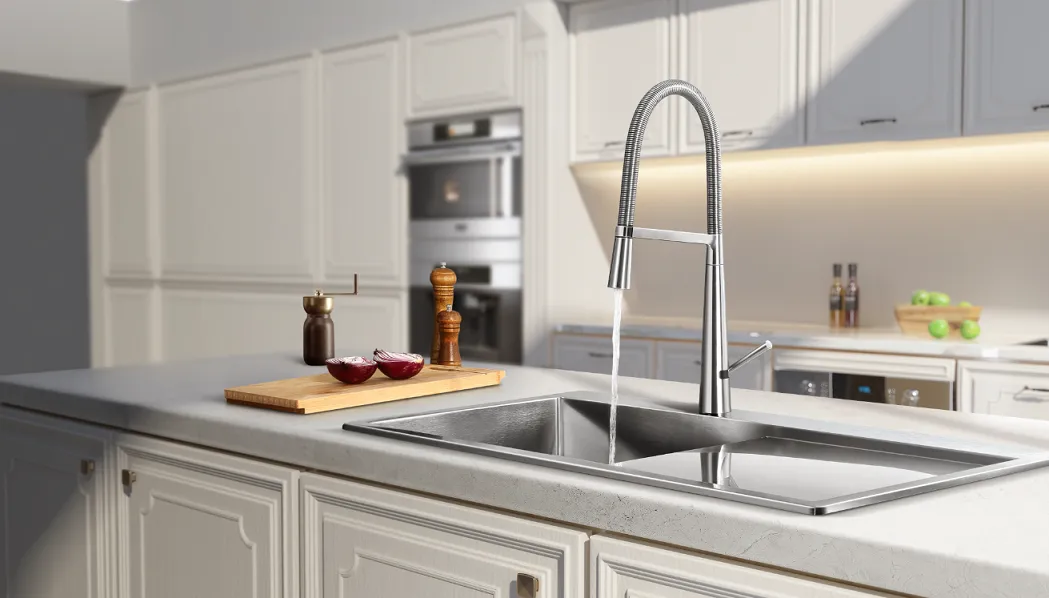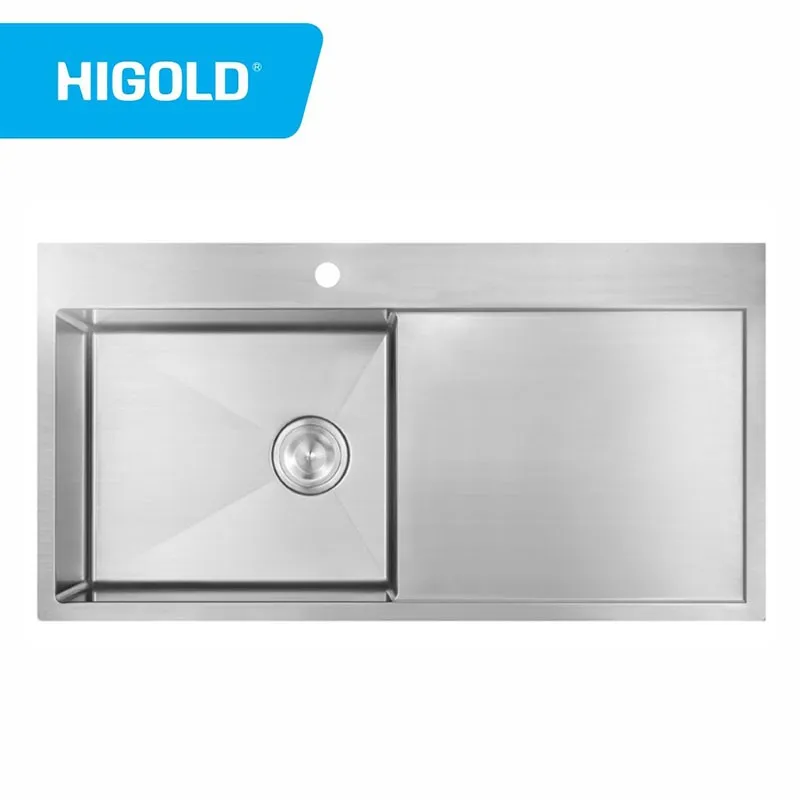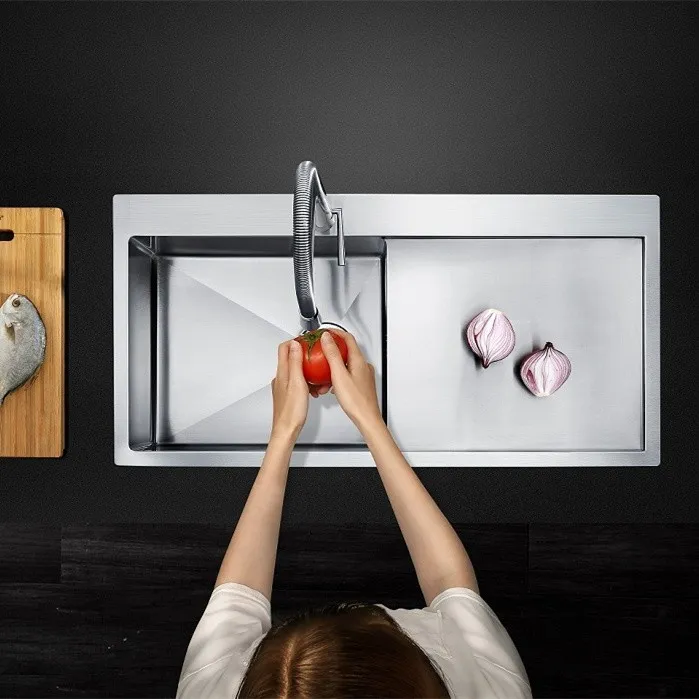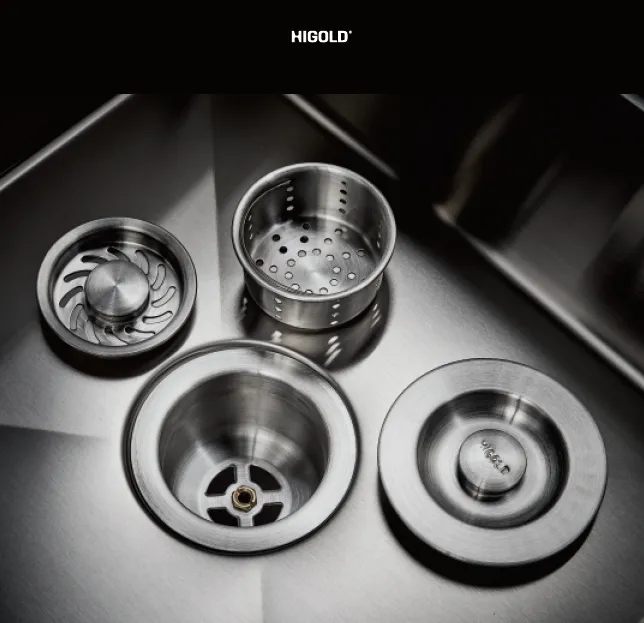Stainless steel kitchen sinks have become a common and indispensable feature in modern kitchens. Their durability, ease of cleaning, and corrosion resistance ensure they maintain their glossy finish even after years of use.
Many consumers gradually discover that, over time, their stainless steel kitchen sinks may develop scratches, water stains, dark spots, and even lose their original luster.
Polishing becomes an important method for restoring their beauty and extending their lifespan. This leads to a common question: How often should a kitchen stainless steel sink be polished? This seemingly simple question involves many factors, including material properties, usage environment, cleaning habits, and maintenance methods.

Stainless Steel Kitchen Sinks: The Necessity of Polishing
Stainless steel kitchen sinks are typically made of various grades of stainless steel, such as 201, 304, or 316. Their surfaces are often treated with finishes such as brushed, frosted, or mirrored. While these treatments can improve aesthetics and durability to a certain extent, over time, the surface will still be affected by friction, acid and alkaline corrosion, and hard water deposits, gradually losing its original luster.
1. The Importance of the Oxide Passivation Film
Stainless steel has a naturally formed chromium oxide passive film on its surface, which effectively blocks air and moisture, preventing further oxidation. However, if this passive film is damaged, such as by scratches or chemical attack, it can cause localized gloss loss or rust. The polishing process actually repairs the surface and promotes the re-formation of the passive film.
2. The Aesthetic Benefit of Polishing
Polishing not only removes scratches, water stains, and grime, but also restores the luster of a stainless steel kitchen sink, keeping it looking like new and enhancing the overall cleanliness of the kitchen environment.
3. The Protective Effect of Polishing
Polishing can reduce small scratches and dirt spots, reducing the risk of bacterial growth. This is particularly important in the daily use of kitchen stainless steel sinks.
Thus, the material of the stainless steel kitchen sink itself determines the necessity and frequency of polishing.

Polishing Frequency for Stainless Steel Kitchen Sinks: What Influences It?
To answer the question, "How often should a stainless steel kitchen sink be polished?", we must first understand the factors that influence polishing frequency.
1. Frequency of Use
• High-Frequency Use: If a kitchen stainless steel sink is used frequently daily, it is prone to water stains and grease, requiring more frequent polishing.
• Low-Frequency Use: If a household uses it less frequently, the polishing interval can be extended.
2. Water Quality
• Hard Water Regions: Hard water with high mineral content is more likely to leave stubborn scale deposits on the sink surface, necessitating shorter polishing intervals.
• Soft Water Regions: Stainless steel kitchen sinks tend to be less contaminated due to less sediment, so the polishing interval can be extended appropriately.
3. Cleaning Habits
• Prompt Drying: Cleaning and drying a stainless steel kitchen sink promptly after each use can significantly extend the polishing interval.
• Leaving Water Marks: If water droplets are left to dry naturally for a long time, dark spots can form, requiring more frequent polishing.
4. Material and Craftsmanship
• Mirror Polish: The surface is bright but easily scratched, so polishing is usually more frequent.
• Brushed Matte: The surface texture hides minor scratches, making it more durable and allowing for longer polishing intervals.
• High-end materials such as 316 stainless steel: They are more corrosion-resistant and require less frequent polishing.

How often should a stainless steel kitchen sink be polished?
Based on a comprehensive consideration of material properties, environmental conditions, and daily habits, industry experts generally agree:
1. Daily Home Use
It is recommended to lightly polish a stainless steel kitchen sink every 3 to 6 months. This not only maintains the gloss but also effectively prevents rust and dulling.
2. Highly Used or in Hard Water Areas
For households with heavy daily use of kitchen stainless steel sinks, or in areas with hard water, it is recommended to polish every 1 to 2 months to prevent excessive mineral deposits.
3. Low-Frequency Use or Excellent Environment
If the sink is used infrequently, in a dry environment, and maintains good cleaning habits, polishing can be done every 6 to 12 months.
4. Special Circumstances
If a stainless steel kitchen sink shows noticeable scale buildup, loss of gloss, or localized rust, it should be polished immediately, regardless of the polishing cycle.
If a special stainless steel protectant is used, the polishing cycle can be extended.
What is the correct method for polishing a kitchen stainless steel sink?
Even if a polishing cycle is clearly defined, improper use can backfire. Therefore, proper polishing is crucial.
1. Choosing the Right Tools
It is recommended to use a soft sponge, microfiber cloth, or a stainless steel polishing cloth.
Do not use steel wool or rough scouring pads to avoid scratching the surface of the stainless steel kitchen sink.
2. Using a Special Polish
Select a neutral polishing compound that does not contain strong acids or alkalis.
A small amount of toothpaste can be used as an alternative, but avoid long-term dependence.
3. Polish Along the Brushed Grain
For stainless steel kitchen sinks with a brushed finish, polish along the original grain to maintain the overall aesthetic.
4. Thoroughly Rinse and Dry
After polishing, rinse thoroughly with clean water to remove any residual polish. Finally, wipe dry with a dry cloth to prevent new water marks.

Stainless Steel Kitchen Sinks: The Relationship Between Polishing and Daily Cleaning
While polishing is important, it's not the only method of daily maintenance. Proper daily cleaning can significantly reduce the frequency of polishing.
1. Daily Maintenance
• Rinse the kitchen stainless steel sink with clean water after each use.
• Avoid prolonged immersion in salty, acidic, or alkaline liquids.
• Dry after use and keep the sink dry and well ventilated.
2. Combine Light Cleaning with Deep Polishing
• Daily cleaning can remove most stains.
• Polishing primarily targets stubborn scratches, scale, and gloss loss.
• Combining these two methods maximizes the beauty and durability of your stainless steel kitchen sink.
Consumer Misconceptions About the Frequency of Polishing Stainless Steel Kitchen Sinks
1. Believing Polishing is Not Necessary
Some consumers mistakenly believe that stainless steel will always shine like new, and therefore neglect polishing. In reality, kitchen stainless steel sinks can easily accumulate dirt and scratches if not polished regularly.
2. Polishing Too Frequently
Some consumers frequently use strong polishing agents, which can wear down the surface and shorten the lifespan of their kitchen stainless steel sinks.
3. Using Improper Tools
Using steel wool or rough tools for polishing will not only fail to restore the gloss, but can also cause permanent scratches.
How Often Should a Stainless Steel Kitchen Sink Be Polished?
—The answer is not fixed; it depends on the usage environment, cleaning habits, and material. Generally speaking, a light polish every three to six months is suitable for most households. Frequent use or harsh environments may require a shorter period, while regular maintenance can extend the period.
Polishing is not only aesthetically pleasing but also crucial for protecting your stainless steel kitchen sink. A sound polishing frequency and method can effectively extend the lifespan of your sink, ensuring it maintains its shine and durability over time.
Does Higold supply replacement parts and accessories?
Yes, Higold provides replacement components such as strainers, drainage systems, and faucet cartridges. These parts can be included in wholesale shipments or ordered separately. For distributors and retailers, offering replacement parts enhances customer service and builds brand loyalty, while maintaining a steady sales stream.


